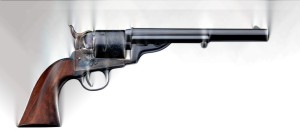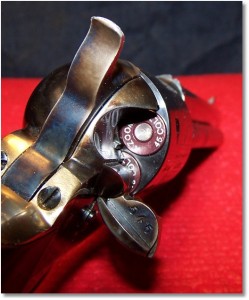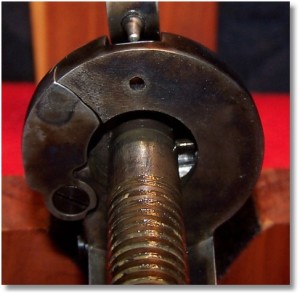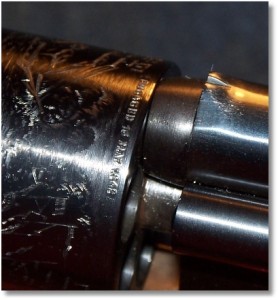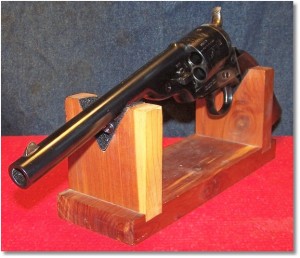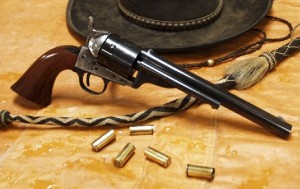In 1871 Colt’s had patented at least two rear-loading revolvers using metallic cartridges: the Colt House Revolver and the Open Top. The House revolver went into production the same year in 1871 but the Open Top didn’t start production until 1872. These were true “cartridge” revolvers unlike those that had been converted from black powder to cartridge cylinders, such as the 1851, 1860, and 1871 Colt revolvers.
The 1872 Army Open-Top revolver was submitted to the U.S Army for acceptance as a new revolver but was rejected; The Army asked for a more powerful caliber with a stronger frame. Two colt engineers, Charles Richards and William Mason were instrumental in developing cartridge-converted revolvers up until 1871 when the first true “cartridge’ revolver was developed. Colt went back to the drawing board. Mason redesigned the frame to incorporate a top-strap, similar to the Remington revolvers, and placed the rear sight on the rear of the frame; he consulted with Richards on some other improvements. This new gun was chambered for the newest caliber known as the .45 Colt and the 1873 Colt Single-Action Army revolver was born, accepted by the U.S. Army and became what we know of today as the “Peacekeeper” and still remains so. Even with the rejection by the U.S. Army, approximately 7,000 1872 Colt Open-Top revolvers were manufactured from 1872 to 1873 and were carried by many.
The 1872 Army Open-Top Revolver was, in my mind, the turning point that would make Colt the leading manufacturer of revolvers for years to come. And, for this reason, I wanted one.
Unlike my Uberti reproduction of the 1871 Colt Navy, with its brass trigger guard and grip-frame, the Uberti 1872 Army Open-Top Revolver is an all steel-framed revolver sporting the “Cavalry” barrel length of 7 ½ inches just like the original. The chambering of the Uberti reproduction is; however, in .45 Colt in keeping with the rest of my collection. Needless to say those .44 Henry rim-fire cartridges (the original chambering) are no longer available
The cylinder, as well as everything forward of it and the trigger guard and grip-frame, is nicely blued steel while the receiver and side loading gate is color-hardened steel that lends a nice contrast to the rest of the revolver. As part of the conversion to cartridges from percussion revolvers, the 1872 Army Open-Top Revolver has a spring-loaded ejector rod that assists in ridding the revolver of spent cartridges. Similar to the ejector rod used on later 1873 Colt “Peacemaker” revolvers, the ejector rod is on the right side of the barrel (secured by a heavy screw in the frame) and has a small lever that must be first rotated upward and then rearward to expel the spent cartridge. A loading gate keeps the rounds within the cylinder and a simple push of the gate outward releases the loading gate.
The cylinder in this particular model holds 6 rounds of .45 Long Colt, although other models are available in .38 special. Like all cartridge conversion reproductions by Uberti, the revolvers can fire modern smokeless powder or cartridges with black powder. High pressure loads are not recommended and any “SASS” approved “Cowboy” ammunition should provide years of enjoyment and service from these revolvers.
The “Flash Gap”, the distance between the forcing cone and the face of the cylinder is less than .004-inches (the thinnest feeler gauge that I have). The forcing cone end of the barrel slopes nicely into the cylinder area, which is true to the original design of these revolvers. Unlike revolvers with top straps, where hot gases are forced into the top strap when a cartridge fires, the open-top revolver allows hot gases to escape upward with nothing to stop them. Spacer blocks between cylinder and frame were common as were two-part cylinders where the cylinder had to be removed from the revolver for loading and reloading. The Richards/Mason conversion removed all of that stuff and what resulted was a cartridge revolver that loaded and unloaded via a side gate that is also part of the recoil shield.
The cylinder does not have recessed chambers; there is a gap between the rear of the cylinder and the frame. This gap allows the shooter to instantly see if the firearm is loaded. The cylinder locks up tight and there is absolutely no play front-to-rear or side-to-side. This revolver is fitted tightly and that attest to the quality of Uberti reproductions.

1872 Uberti Army Open-Top Revolver – Open Loading Gate Showing Massive Chambers for the .45 LC Cartridge
The cylinder has scrollwork just like the original (a naval battle) has and is not fluted, which adds strength to the cylinder. Chamber thickness is about .047 inch, so no, this is not a Ruger and ammunition should be selected to compliment the firearm and not destroy it. For 230-grain .45 LC ammunition, I like to stay around the 850 fps velocity if not under, which is a comfortable load to shoot. If I want to run hot loads, I’ll go to the Ruger Blackhawk.
Unlike the original 1872 Colt Open-Top revolver, the hammer in the Uberti 1872 Army Open-Top Revolver incorporates a safety block that operates by the turn of a screw, which keeps the firing pin from protruding into the frame. The screw can only be seen when the hammer is in the half-cock or fully cocked positions. Although the block safety does move away from the original design, I have come to not notice it all.
The firing pin is part of the hammer and plunges through a corresponding hole in the frame to strike the cartridge. This is definitely not a revolver to carry with six rounds. If the hammer is struck or dropped over a live round, something not so nice will happen when the cartridge fires. As with all revolvers of this nature; move the hammer to the half-cock position, load one, skip one, load four, pull the hammer to the full cock position, and then use the thumb to control the descent of the hammer while the trigger is pulled and comes to rest on an empty chamber.
It is not advised to dry-fire this revolver and use of snap caps is highly recommended. I use those by A-Zoom for dry-firing the revolver. You can see those chambered in the firearm in the accompanying image.
There is absolutely no take-up in the trigger and (on this particular model) the trigger breaks crisply at a hair less than three pounds with just a hint of over-travel. As the trigger in the Uberti 1872 Army Open-Top Revolver wears in, I am sure that it will smooth out and become lighter still.
Some say that the open-top revolver was not as strong as those with a closed top. That could be argued as the open-top revolver using a much thicker cylinder pin that is found on closed-top revolvers and which aids to the strength of the open-top revolver. The cylinder is held into place by a wedge that is inserted and locked into a very robust frame. To take-down an open-top revolver of this type, a screwdriver is used to turn the retaining screw until it is parallel with the cylinder pin. Although it is possible to push the wedge through the frame after a few sessions of disassembly, sometimes it takes a small hammer and something soft to get the wedge started. Afterward it can be plucked from the frame and set aside. The barrel is then grabbed and pulled forward off of the cylinder pin. The cylinder is then rotated off of the cylinder pin. To assembly the revolver; the hammer is pulled slightly rearward, the cylinder is pushed onto the cylinder pin and then rotated slightly until it engages the cylinder hand (the part that rotates the cylinder), the barrel assembly is then pushed onto the cylinder pin (two mating pins are part of the frame assembly and mate with two holes in the barrel assembly, the wedge is inserted into the frame and lightly tapped into place, and the locking screw is turned just enough to secure the wedge into the frame. With a practiced hand, disassembling the open-top revolver can be performed faster than field stripping a 1911 Colt pistol. Care must be taken to prevent the wedge too far into the frame, as the wedge also contributes to the forcing cone-to-cylinder gap and it is quite possible to bind the cylinder.
The Uberti 1872 Army Open-Top Revolver weighs in at 2.2 pounds dry and has enough handle to hold onto. The wide and flared grip bottom helps in keeping muzzle rise in check while the shape of a grip allows the revolver to roll back in the hand, which puts the hammer spur within easy reach of the cocking thumb. The hammer spur has a diamond-shape pattern to ensure a good surface for cocking. The hammer has a deep valley in which to rest the thumb during cocking or holding the hammer while de-cocking. The grip itself is a one-piece wood affair with the usual Uberti stain but slightly darker in color than most Uberti revolvers that I have and have seen. According to Uberti, the wood is Walnut. They are well mated to the grip frame and are nice enough to not consider refinishing or replacement. I like the dark wood grips, as they lend a rich touch to the revolver.
Surprisingly, the revolver is nicely balanced. With a 7 ½-inch barrel, you would expect the revolver to be barrel-heavy. This; however, is not the case when five .45 LC rounds are loaded into the chambers of the cylinder.
The steel back strap and trigger guard is a two piece unit that is attached to the cold-steel frame by six screws. A single screw mounts the back strap to the trigger guard. On the left side of the revolver, just behind the trigger guard, the caliber of the firearm is stamped. The firearm’s serial number is stamped on both the frame and the brass just beneath the cylinder at the front. 1871 is stamped into the frame just above the disassembly wedge. Also, and just below the cylinder on the left side of the frame, two patent marks are stamped that denote the patents in 1871 and 1872. The top of the barrel is stamped with manufactures stamps;
Sights on the 1872 Army Open-Top Revolver are quite unique. The front sight is a fixed bladed sight that is inset on the front of the barrel while the rear sight is unique in that the rear sight is a raised notch at the rear of the barrel near the forcing cone. Since the 1872 Army Open-Top Revolver, like the 1871 model, was an open-top revolver there were not too many choices in providing a rear sight. On some open-top revolvers, there was a sighting notch cut into the hammer; when the hammer was at full cock, the front sight was aligned with the rear sight – the hammer. With the 1872 Army Open-Top Revolver, the front sight is aligned with the raised rear notch. The front sight and the rear notch are very thin. These were more instinctive shooting firearms than target revolvers; simply point the barrel in the right direction and pull the trigger. However, it is surprising how accurate these firearms can be when time is taken to actually use the sights.
Although I have always felt that the Remington revolvers were superior to the Colt revolvers of the day, the Colt Open-Top revolvers were exceptional and are now more exceptional due to modern manufacturing and materials of the reproductions. The Uberti 1872 Army Open-Top Revolver fills a niche in my humble collection in that the original was a stepping stone to a more advanced single-action revolver design for Colt; the 1873 Colt SAA.
RANGE TIME:
Folks unfamiliar with revolvers of this nature discount them because of their supposed poor accuracy. Nothing could be further from the truth; they are as accurate as any modern firearm at “combat distances” and beyond.
I still had some PROGRADE .45 Colt 250-grain Cowboy Grade ammunition left over from a previous shoot and decided to put twelve more downrange for function testing. A simple target was posted at fifteen yards and I wanted to see how the 7.5-inch barrel would perform.
I am in the habit of firing SA revolvers from a standing one hand position. As my usual with a single-action revolver, my first two shots were high left. Dropping the sight picture to a six o’clock hold and trying to concentrate on the very narrow front sight and rear channel, I put four shots pretty close to the center. Another round of six rounds was fired and I have to say that the accuracy of the Uberti 1872 Army Open-Top Revolver was on par with the 1871 Colt Navy, the 1858 Remington New Army conversion, and the 1875 Remington New Army revolvers in the collection. As with the 1871 Colt Navy, I was expecting much more flash from the top of the forcing cone, due to the revolver not having a top strap, but was surprised how little side flash there actually was. Perhaps, it was due to the tight forcing cone-to cylinder or simply the shape of the outside of the barrel at the forcing cone. At this point I really don’t know, as the 1871 Colt Navy is the same way.
What I do know is that the Uberti 1872 Army Open-Top Revolver is a fine piece of work, it is a natural pointer for me, and accurate enough to make me want to shoot it more. The Uberti 1872 Army Open-Top Revolver also looks great and makes me appreciate the modern firearms that we do have available to us.
SUMMARY:
While stiff when new, everything is breaking in well, and the Uberti 1872 Army Open-Top revolver is starting to show its mettle. While very similar in appearance to the 1871 Colt Navy Open-Top revolver, which was never used by the Navy, the 1872 Army Open-Top revolver is a welcome addition to my family of Uberti reproduction revolvers.
The 1872 Army Open-Top revolver was, I believe, the revolver that actually won the west. Without its rejection by the U.S. Army, the 1873 Colt SAA may not have been developed until later. I would say that we should be glad that the 1872 Army Open-Top revolver was rejected.
RESOURCES:
Uberti Firearms (Conversions and Open-Top Revolvers: http://www.uberti.com/army-conversion-navy-conversion-and-open-top-revolvers
![]()


